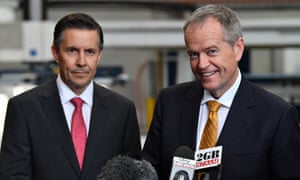Extract from The Guardian
Scott Morrison wants voters to think that Bill Shorten is risky and reckless – but no one needs to grab the smelling salts
It’s been a strange campaign in some respects, and the so-called
debate about climate policy has been deeply strange. With new numbers
doing the rounds about the cost of Labor’s climate policy, it’s a useful
time to work through the issues step by step.
Mind the assumptions
The new modelling that’s generated headlines on Wednesday morning is work from economist Brian Fisher.
Fisher is a respected economist who used to head up Australian Bureau
of Agricultural and Resource Economics. Of course it’s important to
consider the costs of action, policy shouldn’t be formed in a vacuum,
but economic modelling is like a cake – it reflects what you put into
it. It’s the sum of its ingredients, and a lot of experts take issue
with Fisher’s underlying assumptions. I’ll give you a couple of concrete
examples. Fisher’s cost of abatement curve is very high. (In plain
English, this means the assumed costs of managing pollution). Some
experts say Fisher’s cost curve is up to 10 times higher than other
economic modellers. Frank Jotzo from the Australian National University
says Fisher’s abatement costs go up to $600 per tonne of CO2 reduced,
when the real world costs today are $100 or less. Another specific
example. Fisher assumes the cost of energy storage is high, up to $200
MW/h. To get some perspective on this, Snowy Hydro is selling firmed
renewable energy today (that means energy with storage) at $70 MW/h. So I
repeat, what goes in to the model determines the numbers that spit out
the other side.Are we talking about the important things in this election?
No. Really, we’re not. Let’s take a minute to consider how the campaign debate is being framed. Instead of beginning at the logical starting point, looking at what the climate science tells us, and understanding the risks associated with failing to take action (which is the conventional conversation), the Australian campaign conversation is wedged in a cul-de-sac about the (alleged) costs of acting to avoid the worst-case scenario. We are stuck in a loop of Big Scary Numbers™ not because that’s the most fundamental issue to consider, but because Scott Morrison wants voters to think that Bill Shorten is risky and reckless. That’s why we are here. It’s about politics. One point about the alleged costs – I say alleged costs because forecasts are forecasts. They are not facts. Hold that thought, because we are going there nextMind the assumptions
Are the Big Scary Numbers™ big and scary?
Not really. This is the funny thing – even though Fisher’s numbers about the impacts of Labor’s policies are higher than other sophisticated guesstimates, no one needs to grab the smelling salts, but understanding that point does require a sense of proportion, and a willingness to report information in proper context. Under the four scenarios Fisher modelled, gross national product declines by between $542bn to $264bn over 10 years when compared to the reference case. If you accept Fisher’s four scenarios are in the ballpark (and a reminder, there are questions about that given the assumptions are contested) then the estimated cost needs to referenced against the size of the Australian economy in 2030, which is expected to be more than $2tn. Let’s say that again. $2tn. One more point that gets a bit lost in the mix when politicians use hyperbole like a 45% emissions reduction target will be “a wrecking ball” in the economy – Fisher’s calculations say Australia’s economy continues to grow with a higher target. Growth does not go backwards.What’s the cost of not acting?
We don’t know, because Fisher didn’t consider that. He considered that particular question – a pretty fundamental one if you think about it – beyond his scope. The other thing he failed to consider was the cost of ongoing policy uncertainty associated with the last 10 years of brain dead hyper-partisan brawling about climate change. Just to illustrate this point: prominent economist Warwick McKibbin argued in 2015 that policy uncertainty would have a more substantial negative impact on real GDP than taking action on emissions reduction consistent with the Paris agreement. He said ongoing policy uncertainty leads to a lack of investment in new generation, and a slowdown in investment in the energy sectors raises the price of energy significantly, which flows through to economic activity. There’s no free lunch here.Labor says it’s impossible to accurately cost its policy right now – is that right?
A final word about permits
One of the more bizarre elements of the election debate has been the debate about permits, not only because the subject is so arcane (you are in a pretty strange place when permits becomes your killer political point) – but also because of a basic logical contradiction. Scott Morrison has zeroed in on permits as symptomatic of the costs Labor wants to impose as a consequence of its climate policies. It’s a weird component to pick on, given permits lower the cost of abatement. This is an orthodox point, and Fisher’s analysis makes that abundantly clear. It’s weird too, because the Coalition decided in 2017 it would use international permits itself for exactly the same reason Labor is planning to use them. Adding international permits to the mix was government policy until about a month before the election. Pretty cynical, right? But doesn’t that sum up the ridiculousness of Australia’s ridiculous climate debate?

No comments:
Post a Comment